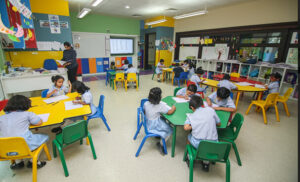Problem-based learning (PBL) promotes student ownership of their educational experience since it requires them to actively do research, evaluate information and data, and collaborate with others to find useful answers. If you want your child to learn in an environment where problem-based learning is utilised, you may consider enrolling him or her in an Indian school in Abu Dhabi.
What is Problem-Based Learning?
An innovative method of teaching called problem-based learning encourages students to collaborate, think critically, and solve problems. PBL entails posing challenging, real-world issues to pupils and assisting them as they seek solutions.
What are the benefits of using problem-based learning in schools?
Here are five advantages of problem-based learning in schools:
1.Develops Critical Thinking Skills
Critical thinking skills are highly important for students. Problem-based learning helps students to think critically and make decisions based on logic.
2.Increases Motivation
Active participation and group work are frequent components of problem-based learning, which can boost student engagement and motivation. Students who work in groups may exchange problem based learning ideas, provide support for one another, come up with new ones, and gain knowledge from their colleagues.
3. Promotes Deeper Understanding
Problem-based learning enables students to apply their knowledge to tackle challenging challenges in the real world. Students’ understanding of ideas and principles is deepened because of this method’s increased depth and relevance.
4. Develops Collaboration And Teamwork Skills
Collaboration and cooperation are emphasised in problem based learning for kids, which aids in the development of key competencies necessary for success in a variety of disciplines. Working in groups develops teamwork, communication, and decision-making abilities, all of which are beneficial in the business.
5. Fosters Self-Motivated Learning
As it places students in control of their education, problem-based learning encourages self-directed learning. Students are encouraged to take ownership of their learning by actively participating in problem-solving, which makes them more motivated learners.
How Do Students Learn from Problem-Based Learning?
Students gain knowledge of the subject matter and the approaches employed by professionals in their industry through the collaborative project creation process. In comparison to conventional lecture-based methods, this kind of learning environment can boost motivation, include various senses in active learning experiences, and achieve long-term mastery.
What are the characteristics of problem-based learning?
Here are five characteristics of problem-based learning:
1.Problem-Based Learning is Student-Centred
Learners are put at the centre of the learning process in a PBL setting. The instructor acts as a facilitator, offering assistance and direction throughout the learning process. The learning process is actively engaged by the students, who are also refining their critical thinking abilities and creating knowledge of the issue at hand.
2.Pbl is Built On Collaboration
PBL encourages students to collaborate in groups, exchange knowledge, and provide solutions to the issue at hand. PBL promotes social interaction and teamwork. This cooperative learning environment prepares students for the workforce, where working together to solve issues and accomplish goals is essential.
3. PBL is Interdisciplinary
PBL employs an interdisciplinary approach, combining information from several academic disciplines to address contemporary issues. This strategy demonstrates to students that real-world problems are not resolved in silos but rather by combining information from several academic fields.
4.PBL is Inquiry-Based
PBL encourages students to pose queries and ask questions. In a PBL environment, students are encouraged to develop skills of investigation and inquiry, facilitating more in-depth learning. Students are prepared to become autonomous learners who investigate and support their learning via inquiry-based learning.
5.PBL is Outcome-Based
Instead of the learning process itself, PBL focuses on the results. PBL’s goal is to address the current issue, not to achieve a certain outcome. This gives students the freedom to consider other methods of approaching the topic without feeling limited by already-established answers.
How does problem-based Learning Help Students?
Here are some problem based learning examples:
1. Helps Students To Develop Real-World Problem-Solving Skills
PBL aids in the development of practical problem-solving abilities in pupils. Instead of merely memorising theoretical knowledge, it gives kids the tools to think critically about societal concerns. Students frequently get an understanding of how different subjects are related via this method, which is not possible through typical textbook learning.
2. Promotes Active And Collaborative Learning
PBL encourages collaborative and active learning. Specifically, instruction calls for participation from students in defining and resolving issues. Students learn from one another and cultivate social skills that are crucial for future partnerships by working in groups.
3. Enhances Students’ Interest And Engagement In Learning
PBL increases students’ interest in and involvement in their education. The practicality of their efforts engages and motivates students as they work on real-world issues. PBL encourages students to express their creativity and design their own learning objectives, which promotes a sense of ownership over the learning process.
4.Encourages Students To Apply New Knowledge In Practice
PBL allows students to put new information into practice, which improves their comprehension of ideas.
How is Problem-Based Learning Different From Inquiry-Based Learning?
Critical thinking and real-world application of information are emphasised in the teaching approaches of problem-based learning and inquiry-based learning (IBL). IBL focuses on student-led studies into certain themes, whereas PBL entails presenting students with real-world challenges to address. While both strategies place a high value on active participation and group problem-solving, PBL varies from IBL in that it places more focus on creating answers to difficult, open-ended issues through a planned process of research, analysis, and decision-making. PBL emphasises the blending of several disciplines and viewpoints in problem-solving, whereas IBL frequently focuses on a specific subject or issue.
How GIIS Abu Dhabi Use Problem-Based Learning For Their Students?
In order to foster a learning environment where students may hone their critical thinking and problem-solving abilities, GIIS Abu Dhabi adopts the problem-based learning approach to instruction. The GIIS Abu Dhabi places a strong emphasis on using the PBL technique to improve students’ capacity for independent thought and problem-solving.
The GIIS Abu Dhabi has gone above and beyond to provide its students with practical exposure to the problem based learning methodology. They have a committed group of teachers that serve as coaches to guide pupils through difficult assignments. Additionally, in order to acquire the abilities needed to use the PBL strategy, these instructors attended a certification procedure and received rigorous training. The GIIS Abu Dhabi students are now able to think critically and apply problem-solving techniques to real-world situations because of the teacher’s training and commitment.
Don’t Miss Out: What are the factors that affect student learning?
Conclusion
A teaching strategy called problem based learning for students encourages students to use their critical thinking abilities to solve actual challenges. This kind of instruction has been more and more well-liked in recent years due to its capacity to improve problem-solving abilities and foster a deeper comprehension of the subject matter. Taking school admission in a school that utilises problem-based learning is highly beneficial for children.
Frequently Asked Questions
What is The Goal Of Problem-Based Learning?
The overarching goal of problem-based learning is to encourage students to develop critical-thinking skills by solving complex, ill-defined problems that relate to their professional or academic field. Students have the chance to actively create knowledge through PBL by working together with others and taking ownership of their own learning.
What is The Role Of A Teacher In Problem-Based Learning?
In problem-based learning, the teacher’s job is to serve as a mentor for the students. Instead of serving as the main information provider, the instructor promotes and assists students in researching actual issues and working together to develop answers.
What Are The 5 Principles Of Problem-Based Learning?
The foundation of PBL’s five guiding principles is a learner-centred approach that enables students to take ownership of their education while collaborating with others to find solutions to issues. Beginning with a complex, open-ended problem, creating questions to steer inquiry, conducting a self-directed study, working with peers, and reflecting on the learning process are some of these concepts.
How Do You Use Problem Based Learning In The Classroom?
When using PBL in the classroom, teachers often start by defining a complicated issue that calls for students to engage in critical thinking, research, and cooperation. Students then analyse the issue in small groups, gather data, come up with answers, assess their concepts, and present their results or solutions to the class.
Why is Problem-Based Learning A Significant Skill?
PBL is an essential ability because it helps people to develop into active learners who can identify, assess, and solve issues in the real world. In today’s cutthroat and rapidly changing workplace, the capacity for critical thought and problem-solving is essential for success.





























